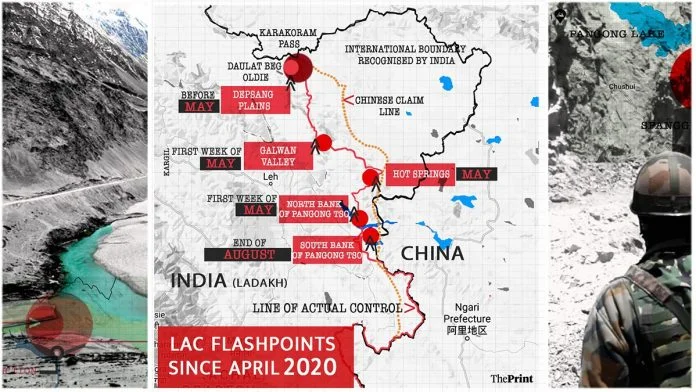
New Delhi: The Indian Army has deployed tanks at forward areas like Chumar, Depsang and Chushul sectors along the Line of Actual Control (LAC) in eastern Ladakh to meet any threat from the Chinese army.
According to the reports, India has deployed T-90 and T-72 tanks along with BMP-2 infantry combat vehicles at Chumar-Demchok sector which is crucial for the defence of the Ladakh sector.
The Indian Army has brought T-90 tanks to the Depsang plains in sub sector north (SSN) where Chinese troops are preventing patrols from going to patrolling points (PPs) 10-13.
The army is preparing to stay put at forward posts in the winter. These tanks have the ability to operate even at minus 40 degrees Celsius.
“The Fire and Fury Corps is the only formation of the Indian Army and also in the world to have actually deployed mechanised forces in such harsh terrain. The maintenance of tanks, infantry combat vehicles and heavy guns is a challenge in this terrain. To ensure crew and equipment readiness, adequate arrangements are in place for both man and machine,” Fire and Fury Corps chief of staff Maj. Gen. Arvind Kapoor told a news agency.
He said the Army is logistically prepared in terms of tackling the harsh weather, with special winter clothing and other facilities such as fuel, spares and assemblies in place.
“Adequate training with provision of special winter clothing will ensure troop morale remains high and they are ready to function at short notice. Along with this, training and honing of crew skills and drills will remain constant through the winters. The Indian Army in eastern Ladakh is logistically well prepared,” he said.
For winters Indian Army is using three types of fuels in these tanks which don’t freeze in sub-zero temperatures.
Earlier this month PLA had brought forward their tanks near the Chushul sector to put pressure on Indian Army after it occupied strategic heights on the south banks of Pangong Tso on August 29-30.
The Depsang plains, situated at an altitude of over 15,000 feet, are flat and suitable for tank action. It is one of the critical points where a thrust by Indian tanks threatens Aksai Chin which was captured by China in 1962.
Last week during the sixth round of Corps Commanders meeting, India and China agreed to stop sending more troops to the frontline, refrain from unilaterally changing the situation on the ground, and avoid taking any actions that may complicate the situation.
However, no breakthrough could be achieved by India and China on the disengagement which means that both sides will keep their troops at the forward post in Ladakh sector during winters when temperature dip to as low as minus 40 degrees Celsius.
Nirbhay Missiles To Counter China Threat: Report
Another report said India has deployed homegrown subsonic missile Nirbhay to counter China’s missile deployment along the Line of Actual Control.
According to the India Today report, the Nirbhay missiles developed by the Defence Research and Development Organisation (DRDO) have been deployed in a limited number for now along the LAC. The report says that the surface-to-surface missile has a reach of up to 1,000 km, which means it is capable of striking targets in Tibet.
“The Nirbhay missile is capable of low-level stealth strike on targets. It means it is capable of flying between 100 metres to four km from ground and pick up the target before engaging it,” the report said, adding “The missile is likely to get full op clearance later,”
The report says that the missile has been in the testing for seven years and Ladakh is the missile’s first deployment.
Speaking about the deployments made by the Chinese, the India Today reported that there has been a sudden increase in China’s deployment of surface-to-air missiles (SAMs) at new locations in Tibet along the Indian frontier.
“Chinese missile sites have come up in areas bordering Sikkim, Arunachal Pradesh, Uttarakhand and Ladakh,” the report says.
Apart from deployment of brand new Nirbhay missiles, the report says Indian troops on the ground have been equipped with tanks and combat vehicles that can operate in harsh winters.
“To counter the Chinese People’s Liberation Army’s deployment of armoured columns, India has its T-90 and T-72 tanks along with the BMP-2 Infantry Combat Vehicles which can operate at temperatures up to minus 40 degree Celsius,” the report says.
It claims that the Indian armoured regiments have the capability to reach the LAC within minutes if they are required and did so recently, when the Chinese activated their tanks after India occupied several heights near the southern bank of Pangong Lake following the incidents of August 29-30.
The report quoted Major General Arvind Kapoor as saying that the army was logistically prepared in terms of tackling the harsh weather with special winter clothing and other facilities such as fuel, spares and assemblies in place.
Follow this link to join our WhatsApp group: Join Now
Be Part of Quality Journalism |
Quality journalism takes a lot of time, money and hard work to produce and despite all the hardships we still do it. Our reporters and editors are working overtime in Kashmir and beyond to cover what you care about, break big stories, and expose injustices that can change lives. Today more people are reading Kashmir Observer than ever, but only a handful are paying while advertising revenues are falling fast. |
| ACT NOW |
| MONTHLY | Rs 100 | |
| YEARLY | Rs 1000 | |
| LIFETIME | Rs 10000 | |











